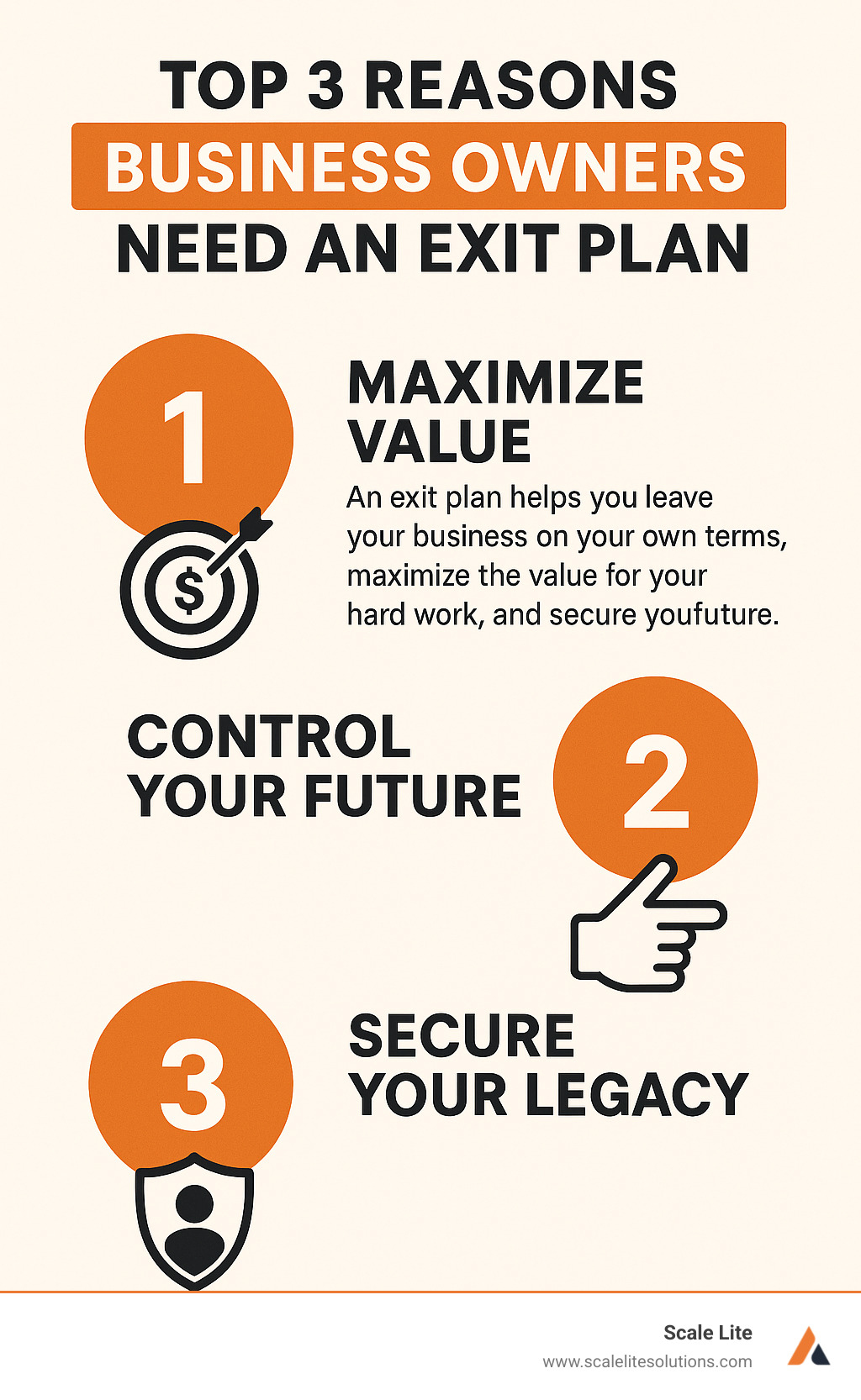
Planning Your Business Exit Without Losing Your Mind

Why Your Business Exit Plan is Essential
A business exit plan is your strategy for stepping away from your company on your own terms. It's the key to maximizing the value of your hard work and securing your future.
Many owners pour everything into building their business but have no plan for their eventual departure. This is a critical oversight.
Consider these statistics:
- An estimated 85% of business owners lack an exit strategy.
- Over 80% of businesses listed for sale never actually sell.
Without a plan, owners risk losing the value they've built, potentially selling for far less than their business is worth or even closing their doors with little to show for it.
This guide provides a clear roadmap to help you plan your departure without stress and uncertainty. You'll learn how to prepare your business, maximize its value, and ensure a smooth transition for your legacy.
I'm Keaton Kay, and my experience in private equity and helping businesses grow has shown me how vital a business exit plan is for an owner's success and peace of mind.

What is a Business Exit Plan (And Why You Desperately Need One)

A business exit plan is your personal roadmap for leaving your company. It's a comprehensive strategy for preparing both yourself and your business for a smooth transition, whether you're selling, passing it to family, or closing its doors. The primary goal is to maximize your company's value and, in turn, what you receive as the owner. But it's also about protecting your legacy, ensuring the business continues to thrive, and meeting your personal goals for the future.
Think of it like planning a road trip: you need a destination and a route. Without an exit plan, you're driving blind, leaving your future to chance. This lack of planning often leads to a heartbreaking loss of value. Only about 2 in 10 businesses listed for sale actually find a buyer, and many of those deals close only after the owner makes significant concessions. A well-designed business exit plan helps you avoid these pitfalls and leave on your terms. It's about building a valuable business that serves your long-term goals. If you're curious about how to make your business more attractive to buyers, you can learn more on building a valuable business here.
Exit Planning vs. Succession Planning: What's the Difference?
While related, exit planning and succession planning are not the same. Understanding the difference is key.
Exit planning is the master plan. It covers all aspects of your departure, including your personal financial goals, tax implications, legal structures, and the method of your exit. It's the complete blueprint for the business's next chapter.
Succession planning is a crucial part of that master plan. It focuses specifically on who will take over the leadership and management of your business. It's about finding and preparing the right people to step into your shoes to ensure the business can run without you. While you can have succession planning without an immediate exit, a successful business exit plan almost always requires strong succession planning to preserve the company's value. Over half of owners hope to pass their business to the next generation, but only about 30% succeed, often due to a lack of proper succession planning. You can explore more about the empirical results on succession planning here if you're interested in the academic side.
The High Cost of Procrastination
Putting off your business exit plan comes with a hefty price. Being forced to sell due to an unexpected event like illness, market shifts, or personal issues almost always means a lower price because you lack the time to prepare.
Proper preparation takes time, often 3 to 5 years. This period is for boosting your business's value by cleaning up finances, streamlining operations, and ensuring it can run without you. Without this groundwork, buyers see more risk and offer less.
The costs of delay are significant:
- Financial Loss: A rushed, forced sale means less negotiating power and unfavorable terms, like less cash upfront.
- Emotional Distress: An unplanned exit can be overwhelming and filled with regret.
- Tax Consequences: Without smart planning, you could face hefty taxes that eat into your proceeds. Planning ahead for options like Qualified Small Business Stock (QSBS) can make a huge difference.
- Employee Uncertainty: A sudden change can cause key employees to leave, further damaging business value.
- Damaged Legacy: Your company might not continue as you envisioned, or it might cease to exist.
As financial expert Andrew Van Alstyne, a certified financial planner who specializes in business transitions, noted: "Many owners are deeply interwoven with their business from a financial perspective. The best way to work through this is by having a plan in place years before you are looking to sell." Don't let procrastination steal the value you've worked so hard to create.
The 8 Common Exit Routes: Choosing Your Destination
Choosing the right business exit plan is a personal decision based on your goals for your life, finances, and legacy. There's no single "best" way to exit; the key is to find the strategy that aligns with your vision. Here's a look at the most common routes:
| Exit Strategy | Potential Value | Speed | Legacy Preservation | Employee Impact | Owner Involvement (Post-Exit) |
|---|---|---|---|---|---|
| Family Transfer | Medium | Slow | High | High Continuity | High (Mentoring) |
| Management Buyout | Medium-High | Medium | High | High Continuity | Medium (Advisory) |
| Third-Party Sale | High | Medium-Fast | Variable | Variable | Low |
| ESOP | Medium | Slow-Medium | High | High Positive | Medium-Low |
| Liquidation | Low | Fast | Low | High Negative | Low |
Internal Exit Strategies: Keeping It in the Family (or Close to It)
Internal strategies involve transitioning your business to people already connected to it, which often preserves the company culture.
- Intergenerational Transfer (Family Succession): Passing the business to family members can be fulfilling and maintain a legacy. However, it requires extensive planning and careful navigation of family dynamics.
- Management Buyout (MBO): Your existing leadership team buys the business. This ensures high continuity, as they already know the operations. The main challenge is often securing financing for the management team.
- Sale to Partners: If you have partners, selling your share to them can be a straightforward and quick exit. The key is agreeing on a fair valuation.
- Employee Stock Ownership Plan (ESOP): This plan transfers ownership to your employees over time through a trust, offering significant tax benefits and boosting morale. As financial advisor Bryce Sanders points out, it gives owners peace of mind knowing their company is "in good hands." However, ESOPs are complex and heavily regulated. Developing your team is fundamental to any internal exit. You can learn more about how this works by developing your team for succession.
External Exit Strategies: Selling to an Outside Party
External strategies involve selling to an outside party, often with the goal of maximizing the financial return.
- Sale to a Strategic Buyer: This is typically a company in a similar industry looking to gain market share, technology, or efficiency. This route often yields the highest sale price.
- Sale to a Financial Buyer: A private equity (PE) firm or similar entity buys the business with the intent to grow it and sell it for a profit later. They look for companies with strong cash flow and growth potential.
- Mergers and Acquisitions (M&A): This broad term covers sales to both strategic and financial buyers. These deals can be complex and time-consuming, but they offer the potential for substantial profit. Most small-to-medium businesses work with investment banks for M&A transactions.
- Initial Public Offering (IPO): Selling shares to the public on a stock exchange is the "holy grail" for some, but it's extremely rare, expensive, and complex for most businesses. An IPO is generally only a realistic option for companies with revenues over $100 million.
The Last Resort: Orderly Liquidation
When selling or transferring the business isn't feasible, orderly liquidation is an option. This involves closing the business, selling off all assets (equipment, inventory), paying debts, and distributing the remaining cash to the owners. While it's a quick way out, liquidation almost always brings the lowest financial return, as intangible assets like brand reputation and customer lists are lost. However, it can be a practical choice if the business is no longer profitable or if you want to move on without the complexity of a sale. For more details, you can find information from the Small Business Administration (SBA).
Your 6-Step Blueprint for a Successful Business Exit Plan

Developing a business exit plan is a long-term process focused on creating value and ensuring a smooth transition. Here is our 6-step blueprint to guide you:
- Define Your "Why": Setting Personal and Financial Goals
- Know Your Numbers: Getting a Realistic Business Valuation
- Boost Your Value: Making Your Business Irresistible
- Assemble Your "A-Team": Who You Need in Your Corner
- Formalize the Plan: Documenting Your Chosen Strategy
- Execute and Transition: Managing the Final Steps
Step 1: Define Your "Why": Setting Personal and Financial Goals
Before planning how to exit, you must know why. This foundation guides every decision. Ask yourself:
- What does my ideal life after business look like? (Retirement, new ventures, travel, etc.) This determines your financial needs.
- How much money do I need from the sale? Work with a financial advisor to calculate this. Estate-planning specialist Amy Wirtz explains that owners should first confirm whether sale proceeds, after fees and taxes, cover their future lifestyle.
- What are my legacy goals? Do you want the business to continue? Do you care about your employees' future?
- What is my ideal exit timeline? A target date (for example, three to five years) helps create a realistic preparation schedule.
Step 2: Know Your Numbers: Getting a Realistic Business Valuation
You can’t set a price without knowing your business’s worth. A professional valuation provides an objective baseline, sets realistic expectations, and identifies areas for improvement. Valuations consider tangible assets (equipment, property) and, crucially, intangible assets like your team’s expertise, customer relationships, and established processes. This isn’t a DIY project—hire a qualified valuation specialist to get an unbiased estimate.
Step 3: Boost Your Value: Making Your Business Irresistible
Once you know your current value and your target value, it’s time to bridge the gap. Focus on making your business as attractive as possible to buyers:
- Reduce Owner Dependency: A business that runs without you is far more valuable.
- Document Processes: Create Standard Operating Procedures (SOPs) for key functions.
- Implement Technology: Modern tools such as CRMs and simple workflow automation demonstrate efficiency.
- Clean Up Financials: Ensure you have at least three years of clean, accurate statements.
- Strengthen Customer Relationships: Diversified, loyal customers and recurring revenue show stability.
Step 4: Assemble Your "A-Team": Who You Need in Your Corner
An exit is a complex process requiring expert guidance. Your team should include:
- Financial advisor
- Accountant or tax professional
- Attorney
- Business broker or M&A advisor
- Business consultant
Step 5: Formalize the Plan: Documenting Your Chosen Strategy
Put your plan in writing. Include your chosen exit strategy, financial projections, timelines, communication plans for stakeholders, and contingency steps for unexpected events.
Step 6: Execute and Transition: Managing the Final Steps
With your plan and team in place, it’s time to execute:
- Due Diligence: Buyers will scrutinize every aspect of your business.
- Negotiation: Your M&A advisor leads negotiations, using preparation as leverage.
- Closing the Deal: Legal and financial teams manage the complex closing process.
- Post-Sale Transition: A well-planned exit ensures a smooth handover for everyone involved.
Frequently Asked Questions about Business Exit Planning
When is the best time to start my business exit plan?
The answer is almost always: as early as possible. Ideally, you should think about your exit from the day you launch your company. However, the next best time is right now. Most advisors recommend starting your formal business exit plan at least 3 to 5 years before your target exit date. This timeframe gives you enough runway to maximize value, prepare the business by cleaning up financials and building a strong team, and explore all your options without being rushed. As financial expert Brian Roth says, "The earlier you begin working on all of this, the more likely you’ll be able to create exactly the future you want for your business and yourself."
What are the biggest mistakes owners make when exiting?
Several common pitfalls can derail an exit plan, costing owners significant value. The biggest mistakes include:
- Waiting too long to start planning: This leads to rushed, reactive decisions and a lower valuation.
- Having an unrealistic valuation: Emotional attachment can cause owners to overestimate their company's worth. An independent, professional valuation is crucial.
- Being emotionally unprepared: Many owners underestimate how difficult it is to let go, which can sabotage a deal.
- High owner dependency: If the business can't run without you, it's far less attractive to buyers.
- Poor financial records: Messy or incomplete financials are a major red flag for serious buyers.
- Lacking a qualified advisory team: Trying to manage the legal, tax, and financial complexities alone is a recipe for disaster.
- No contingency plan: Failing to plan for unexpected events leaves you vulnerable.
How do I ensure my employees are taken care of during an exit?
Protecting your employees is a vital part of your legacy, and your approach will depend on your chosen business exit plan. An Employee Stock Ownership Plan (ESOP) or a Management Buyout (MBO) are direct ways to benefit your team, as they allow employees or existing leaders to take ownership, preserving culture and jobs.
When selling to an outside party, you can still negotiate terms to protect your team. This might include requesting employment contracts for key staff or retention bonuses to encourage them to stay through the transition. It's also wise to seek buyers who share your values regarding employee welfare.
Regardless of the strategy, clear and transparent communication is paramount. As leadership transition expert Mark Valentino advises, "Avoid these barriers by engaging in meaningful, careful communication, and extensive planning.” Keeping your team informed reduces anxiety and helps retain your most valuable talent.
Conclusion: Your Next Chapter Starts With a Plan

The most important takeaway is this: a business exit plan is not just a good idea; it is essential. It is your roadmap to leaving your business on your own terms, with maximum value and a secure future. This isn’t a one-time task but an ongoing journey of making smart choices today to shape your tomorrow.
By defining your goals, knowing your numbers, boosting your value, and working with the right team, you are not leaving your future to chance—you are designing it. A great business exit plan ultimately builds a scalable, efficient, and valuable company that is ready for any future you envision.
At Scale Lite Solutions, we help blue-collar service businesses and companies in low-tech industries achieve this level of operational excellence. We use technology, marketing, and automation—including AI deployment, workflow optimization, and CRM improvements—to drive enterprise value. Our goal is to make your business not just successful, but genuinely exit-ready for your next chapter.
Ready to build a business that not only thrives but also gives you the ultimate freedom of choice? Let’s explore how to build a business that runs without you.






